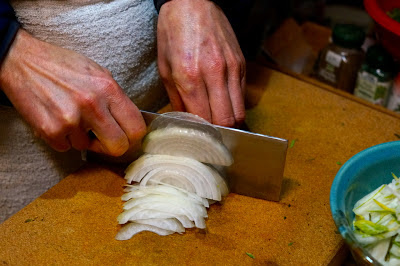 I've learned all kinds of neat tricks and new recipes during our time with Matthew and Dawnen. One of these is how to assemble a Hot & Cold Salad. This is one of Matt's staples, and no wonder; it's absolutely delicious and a really awesome way to get your greens when you don't feel like eating a plain old salad.
I've learned all kinds of neat tricks and new recipes during our time with Matthew and Dawnen. One of these is how to assemble a Hot & Cold Salad. This is one of Matt's staples, and no wonder; it's absolutely delicious and a really awesome way to get your greens when you don't feel like eating a plain old salad.It's a sort of cross between a salad and a stew. Just the thing for those cold winter days coming up!
There isn't an exact recipe, as it greatly depends on what is available and your personal preferences, but here's the basic formula to create an amazing Hot & Cold Salad that will be both satisfying and super nutritious.
Step 1: The Broth
The first thing you want to do is prepare a broth. Matt throws in curry powder (at least 1 tbs), some turmeric and hot pepper into water (4-5 cups or so) that he brings to a boil in a medium to large pot. It takes a while to get the exact measurements right as it will really depend on your taste buds. The amount of water can vary too in accordance to how soupy you like your Hot & Cold Salad.
Allow the broth to simmer for a few minutes in order for the spices to bloom. Set aside with the top on.
Step 2: The Cold Components
I guess it doesn't really matter which part, the hot or the cold, you start working with. You'll be basically chopping all sorts of veggies, greens and herbs and putting these into different bowls. Your choice of components can vary, but you'll most likely want to have in there a variety of mild flavored greens.
Lettuce
Arugula - my all time favorite salad green!
Now a few veggies...
Cucumber. This one came from his garden and the seeds were a little big so he scooped out the core first before slicing it thinly.
I really like Matt's technique for slicing peppers. First he cuts the top off and take out the seeds. Then he cuts the pepper in half. Next he places one side onto the other and set them on the board sideways in order to slice them, which is the opposite direction from the way I used to do mine.
He also used some celery bias but somehow I've misplaced the pic. Also some fresh herbs...
Basil
Piling up mint leaves before chiffonading them.
Chives cut at a bias
You can throw all of your thinly sliced components into a large bowl, except for the more intense ones that you'd like to sprinkle on top.
Mix cold components well.
Lovely little toms from their abundant harvest
In there will go whatever greens or veggies that you would like to lightly cook so as to soften their flavor and texture. For instance you might want to keep your more fibrous greens, such as kale, for this hot part. In the salad that Matt prepared that day he used...
Cabbage
... celery leaves
... and parsley root leaves
As you can see, you want to chop all of the different components quite finely. It makes for a nicer texture and also will ensure that the short time spent on the stove will manage to tenderize them.
It's easier to transfer the various components into different bowls as these will go into the pot separately. You can certainly put all the greens together though if you'd like.
Other veggies you might want to throw into the hot part of the salad include carrots (which he had already julienned by the time I arrived), other types of greens, such as collard, beet tops or Swiss chard, broccoli, cauliflower, perhaps even squash.
Step 4: Heating the Hot Components
Now that you've got all of your cold and hot components ready it's time to throw the latter on the stove.
You basically want to layer your veggies, starting with the ones you want most 'cooked', probably finishing up with your greens.
First the cabbage. If it were me I'd throw the onion at that stage as well.
Next came the carrots.
Then the leeks and the greens. At the last minute Matt decided to throw in some of the peppers.
More greens
Finally the onions. The last thing he did was add a couple good handfuls of raisins on top.
Then he covered the pot and returned it to the stove. Bring to a boil. Once it does that, turn the heat down a little and allow to cook for 3 minutes. Turn the heat off and remove the pot from the burner.
In the meantime Matt sliced some coconut palm sugar. He gets it in the form of little balls at the Asian market.
After the 3 minutes have passed, Matt stirs in the palm sugar (or sometime a blended orange), Celtic sea salt and a few tablespoons of some kind of fat to thicken up the broth. He really likes to use Coconut Cream - sold by Tropical Traditions for an amazing price. Make sure to keep an eye out for their two for one special! - and sometime coconut oil (his fave sources are Living Tree Community Foods and Coconut Oil Online.) He mixes everything thoroughly with chopsticks but I'm sure a knife or spoon would do just fine. ;-)
Step 5: Serving
Now is the moment we've been waiting for... To serve the Hot & Cold Salad, begin by scooping some of the hot components into bowls (without the broth).
Next add some of the cold components on top.
Sprinkle by hand some of the more intense herbs, such as mint, and top with chives.
He also threw in some finely sliced nasturtium leaves in there for a bit of a bite.
Finish off with more hot components, this time adding some of the broth.
Some pieces of avocado are also real nice.
You could stop here if you'd like, but now Matt added some of his favorite condiments: homemade Sauerkraut and Coconut Yogurt. He also complimented the dish with a scoop of his yummy reconstituted tomatoes; dehydrated tomatoes soaked for a few minutes in a little hot water, olive oil, palm sugar or honey for sweetness, Celtic sea salt and dried basil or Italian seasoning. You could also add a smidgen of KAL pure stevia extract if you'd like.
Just as an aside, I have to tell you that I've never been fond of stevia, primarily due to its aftertaste, and therefore have avoided it in recipes. When I learned that Matthew did use it quite a bit I set him the challenge of changing my mind. Well he did it! KAL pure stevia extract has virtually no aftertaste to speak of and is so concentrated that you only need a teeny amount. I'm glad I finally made peace with stevia (Yay!) as I know that it's such a healthier sweetener than most.
A few days later I just had to try my hand at creating my own H&C Salad. It went smoothly although it will take a bit of practice to get the spicing just right.
Soooo delish and satisfying!























































































